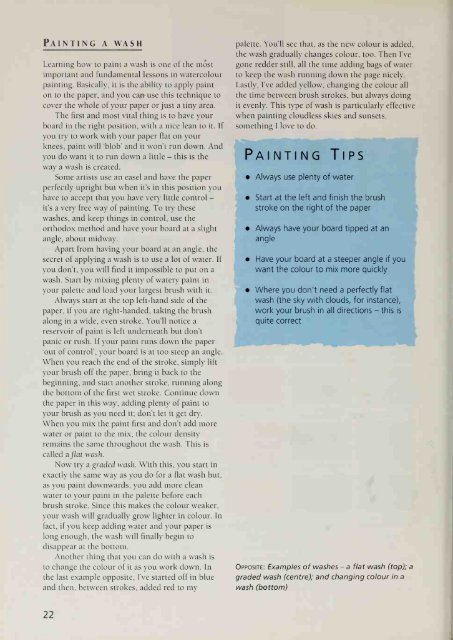A Brush With Art.pdf
Create successful ePaper yourself
Turn your PDF publications into a flip-book with our unique Google optimized e-Paper software.
Painting awashLearning how to paint a wash is one of the mostimportant and fundamental lessons in watercolourpainting. Basically, it is the ability to apply painton to the paper, and you can use this technique tocover the whole of your paper or just a tiny area.The first and most vital thing is to have yourboard in the right position, with a nice lean to it. Ifyou try to work with your paper flat on yourknees, paint will 'blob" and it won't run down. Andyou do want it to run down a little - this is theway a wash is created.Some artists use an easel and have the paperperfectly upright but when its in this position youhave to accept that you have vevy little control -it's a ver)^ free way of painting. To tr}'thesewashes, and keep things in control, use theorthodox method and have your board at a slightangle, about midway.Apart from having your board at an angle, thesecret of applying a wash is to use a lot of water. Ifyou don't, you will find it impossible to put on awash. Start by mixing plenty of watery paint inyour palette and load your largest brush with it.Always start at the top left-hand side of thepaper, if you are right-handed, taking the brushalong in a wide, even stroke. You'll notice areser\'oir of paint is left underneath but don'tpanic or rush. If your paint runs down the paper'out of control', your board is at too steep an angle.When you reach the end of the stroke, simply liftyour brush off the paper, bring it back to thebeginning, and start another stroke, running alongthe bottom of the first wet stroke. Continue downthe paper in this way, adding plenty of paint toyour brush as you need it; don't let it get dr)^When you mix the paint first and don't add morewater or paint to the mix, the colour densityremains the same throughout the wash. This iscalled a flat wash.Now try a graded wash. <strong>With</strong> this, you start inexactly the same way as you do for a flat wash but,as you paint downwards, you add more cleanwater to your paint in the palette before eachbrush stroke. Since this makes the colour weaker,your wash will gradually grow lighter in colour. Infact, if you keep adding water and your paper islong enough, the wash will finally begin todisappear at the bottom.Another thing that you can do with a wash isto change the colour of it as you work down. Inthe last example opposite, I've started off in blueand then, between strokes, added red to mypalette. You'll see that, as the new colour is added,the wash gradually changes colour, too. Then I'vegone redder still, all the time adding bags of waterto keep the wash running down the page nicely.Lastly, I've added yellow, changing the colour allthe time between brush strokes, but always doingit evenly. This t\^e of wash is particularly effectivewhen painting cloudless skies and sunsets,something I love to do.iPainting Tips• Always use plenty of water• Start at the left and finish the brushstroke on the right of the paper• Always have your board tipped at anangle• Have your board at a steeper angle if youwant the colour to mix more quickly• Where you don't need a perfectly flatwash (the sky with clouds, for instance),1 work your brush in all directions - this isquite correctOpposite: Examples of washes - a flat wash (top); agraded wash (centre); and changing colour in awash (bottom)1I22


